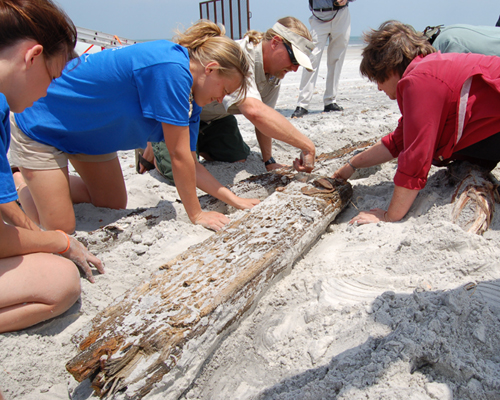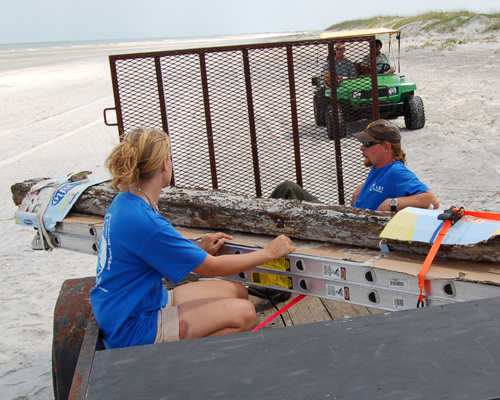
Chuck Meide, Kathleen McCormick, Renee Post and Mallory Valalik removing sand from around the keel.
About two months ago Park Ranger Shelly Young contacted LAMP and informed us that a local shipwreck, that has been buried in the sand, became uncovered and the keel broke free and washed onto the beach. Chuck and I went to investigate the keel Thursday, May 15 to examine its current state and decide how to transport it back to LAMP for proper conservation. When we arrived at the rangers station, we were dismayed to hear from Ranger Mitch that a vandal had sawed the keel into two pieces while we waited for approval to recover it. Ranger Mitch drove us to the site where the keel washed ashore and we immediately began to examine it. Mitch told us there was a noticeable scarf in the keel, which is where two sections of the keel joined together.

Keel sections with cuts.
Ships keels are generally too long to be constructed from one piece of wood, so shipwrights tapered the ends of keel sections and joined them together with iron or wood fasteners. We spotted the fasteners right away, but the tapered scarf took a few more minutes to recognize as it was worm eaten and rotted, making it appear as if the wood had just been degraded rather than shaped. The unfortunate vandalism was also apparent. Two sections of the keel were lying on the beach with definite cut marks on both. After examining the cuts, we determined that the vandals had only sawed it into two pieces, but did not remove any of the wood. This was evident because the cut marks on both pieces fit together.

Keel sections with scarf in larger section and cut in smaller section.
We conferred with Ranger Mitch and decided to recover the keel the following Wednesday at 1:30 in the afternoon. Wednesday, May 21st Chuck Meide, Brendan Burke, Kathleen McCormick, Beau Phillips, Mallory Valalik and I accompanied Park Ranger Dean Cox, and three other rangers to the site in state park truck with a trailer in tow to recover the keel. We began by gently digging the sand away from the wood and Beau photographed all the loose pieces next to where they had been attached before we placed them in a plastic bag.

Loose pieces of wood next to keel and saw marks on top of keel.
Once we had cleared enough of the sand away from the larger section of the keel, we laid a ladder next to it and covered it with cardboard to protect the wood from the metal rungs in the ladder. Six of us tenderly lifted the keel onto the ladder and strapped it down.

Crew lifting the keel onto the ladder for transport.
We covered the worm eaten scarf with more cardboard and secured it with a strap to further protect it during transport to LAMP facilities. We carried the ladder to the trailer and Brendan strapped it to the trailer’s rails. The smaller section was in much better condition and Chuck and Mallory carried it to the trailer and placed it next to the ladder.

Mallory Valalik and Chuck Meide loading small section of keel onto trailer.
Brendan and I rode with the keel to keep an eye on it while we drove it to LAMP, where we unloaded it into our storage shed.

Brendan Burke and Renee Post in trailer with keel during transport.
Friday, May 23rd I cleaned the sand out of the crevices in the keel using a small shop vacuum with a 1/8″ screen over the hose nozzle to prevent any loose pieces of wood from being sucked into the hose. Much of the sand was sticky and stubborn, especially in the deeper cracks and I used a small pliable stick as if it were a dental pick and a paint brush and to work the sand toward the vacuum hose. The job took a lot longer than I had anticipated because the sand stayed moist inside the holes, which made it stick to the wood. I also had to work slowly and carefully so that I wouldn’t damage the keel. Still, several small loose pieces worked their way free and I collected them in a polyethylene bag as I worked.

Renee Post cleaning sand from keel and volunteer Shawn Arnold diligently working.
Although the task was time consuming, my meticulous work allowed me to become more familiar with our newest acquisition before it undergoes conservation. The first step towards conservation, now that most of the sand has been removed, is to desalinate the keel. This process involves extracting the salts that have absorbed into the wood by soaking it in a vat of fresh water. We will periodically test the water’s salt content and change out the bath with new fresh water to lower the salt content. Once the salt levels are low enough, we will determine what method of conservation to use on the keel. Desalination for an object this large can take several months, so we have plenty of time to determine the best method to preserve the wood in the keel as well as the iron fasteners, which may or may not have to be removed, depending on the method we choose.

